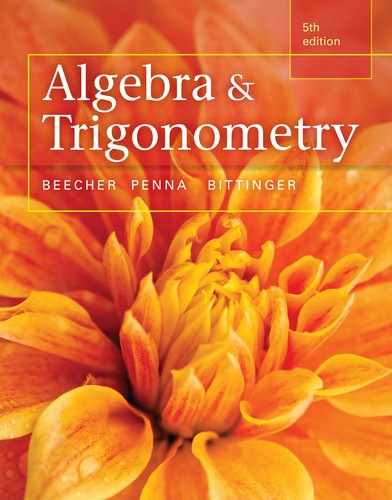9.6 Determinants and Cramer’s Rule
Evaluate determinants of square matrices.
Use Cramer’s rule to solve systems of equations.
Determinants of Square Matrices
With every square matrix, we associate a number called its determinant.
Example 1
Evaluate: |√2−3−4−√2|
Solution

=√2(−√2)−(−4)(−3)=−2−12=−14
Now Try Exercise 1.
We now consider a way to evaluate determinants of square matrices of order 3 × 3
Evaluating Determinants Using Cofactors
Often we first find minors and cofactors of matrices in order to evaluate determinants.
Example 2
For the matrix
find each of the following.
M11
M11 M23
M23
Solution
For M11
M11 , we delete the first row and the first column and find the determinant of the 2×22×2 matrix formed by the remaining entries. M11=|−67−35|=(−6)⋅5−(−3)⋅7=−30−(−21)=−30+21=−9
M11=|−67−35|=(−6)⋅5−(−3)⋅7=−30−(−21)=−30+21=−9M11=====∣∣∣−6−375∣∣∣(−6)⋅5−(−3)⋅7−30−(−21)−30+21−9 For M23
M23 , we delete the second row and the third column and find the determinant of the 2×22×2 matrix formed by the remaining entries. M23=|−80−1−3|=−8(−3)−(−1)0=24
M23=|−80−1−3|=−8(−3)−(−1)0=24M23===∣∣∣−8−10−3∣∣∣−8(−3)−(−1)024
Now Try Exercise 9.
Example 3
For the matrix given in Example 2, find each of the following.
A11
A11 A23
A23
Solution
In Example 2, we found that M11=−9
M11=−9 . ThenA11=(−1)1+1(−9)=(1)(−9)=−9.A11=(−1)1+1(−9)=(1)(−9)=−9. In Example 2, we found that M23=24
M23=24 . ThenA23=(−1)2+3(24)=(−1)(24)=−24.A23=(−1)2+3(24)=(−1)(24)=−24.
Now Try Exercise 11.
Consider the matrix A given by
The determinant of the matrix, denoted |A|
Because
we can write
It can be shown that we can determine |A|
Example 4
Evaluate |A|
Solution
We have
The value of this determinant is −36
Now Try Exercise 13.
Cramer’s Rule
Determinants can be used to solve systems of linear equations. Consider a system of two linear equations:
Solving this system using the elimination method, we obtain
The numerators and the denominators of these expressions can be written as determinants:
If we let
we have
This procedure for solving systems of equations is known as Cramer’s rule.
Note that the denominator D contains the coefficients of x and y, in the same position as in the original equations. For x, the numerator is obtained by replacing the x-coefficients in D (the a’s) with the c’s. For y, the numerator is obtained by replacing the y-coefficients in D (the b’s) with the c’s.
Example 5
Solve using Cramer’s rule:
Solution
We have
The solution is (−129,4129).
Now Try Exercise 29.
Cramer’s rule works only when a system of equations has a unique solution. This occurs when D≠0. If D=0 and Dx and Dy are also 0, then the equations are dependent. If D=0 and Dx and/or Dy is not 0, then the system is inconsistent.
Cramer’s rule can be extended to a system of n linear equations in n variables. We consider a 3×3 system.
Note that the determinant Dx is obtained from D by replacing the x-coefficients with d1, d2, and d3. Dy and Dz are obtained in a similar manner. As with a system of two equations, Cramer’s rule cannot be used if D=0. If D=0 and Dx, Dy, and Dz are 0, then the equations are dependent. If D=0 and one of Dx, Dy, or Dz is not 0, then the system is inconsistent.
Example 6
Solve using Cramer’s rule:
Solution
We have
Then
The solution is (−2,35,125).
In practice, it is not necessary to evaluate Dz. When we have found values for x and y, we can substitute them into one of the equations to find z.
Now Try Exercise 37.
9.6 Exercise Set
Evaluate the determinant.
1. |53−2−4|
2. |−86−12|
3. |4−7−23|
4. |−9−654|
5. |−2−√5−√53|
9. |√5−342|
7. |x4xx2|
8. |y2−2y3|
Use the following matrix for Exercises 9–16:
9.Find M11, M32, and M22.
10. Find M13, M31, and M23.
11.Find A11, A32, and A22.
12. Find A13, A31, and A23.
13. Evaluate |A| by expanding across the second row.
14. Evaluate |A| by expanding down the second column.
15.Evaluate |A| by expanding down the third column.
16. Evaluate |A| by expanding across the first row.
Use the following matrix for Exercises 17–22:
17.Find M12 and M44.
18. Find M41 and M33.
19.Find A22 and A34.
20. Find A24 and A43.
21.Evaluate |A| by expanding across the first row.
22. Evaluate |A| by expanding down the third column.
Evaluate the determinant.
23. |312−23134−6|
24. |3−21243−151|
25. |x0−12xx2−3x1|
26. |x1−1x2xx0x1|
Solve using Cramer’s rule.
27. −2x+4y=3,3x−7y=1
28. 5x−4y=−3,7x+2y=6
29. 2x−y=5,x−2y=1
30. 3x+4y=−2,5x−7y=1
31. 2x+9y=−2,4x−3y=3
32. 2x+3y=−1,3x+6y=−0.5
33. 2x+5y=7,3x−2y=1
34. 3x+2y=7,2x+3y=−2
35. 3x+2y−z=43x−2y+z=54x−5y−z=−1
36. 3x−y+2z=1,x−y+2z=3,−2x+3y+z=1
37. 3x+5y−z=−2,x−4y+2z=13,2x+4y+3z=1
38. 3x+2y+2z=1,5x−y−6z=3,2x+3y+3z=4
39. x−3y−7z=6,2x+3y+z=9,4x+y=7
40. x−2y−3z=4,3x−2z=8,2x+y+4z=13
41. 6y+6z=−1,8x+6z=−1,4x+9y=8
42. 3x+5y=2,2x−3z=7,4y+2z=−1
Skill Maintenance
Determine whether the function is one-to-one, and if it is, find a formula for f−1(x). [5.1]
43. f(x)=3x+2
44. f(x)=x2−4
45. f(x)=|x|+3
46. f(x)=3√x+1
Simplify. Write answers in the form a+bi, where a and b are real numbers. [3.1]
47. (3−4i)−(−2−i)
48. (5+2i)+(1−4i)
49. (1−2i)(6+2i)
50. 3+i4−3i
Synthesis
Solve.
51. |y23y|=y
52. |x−3−1x|≥0
53. |2x112−134−2|=−6
54. |m+2−3m+5−4|=3m−5
Rewrite the expression using a determinant. Answers may vary.
55. a2+b2
56. 12h(a+b)
57. 2πr2+2πrh
58. x2y2−Q2
